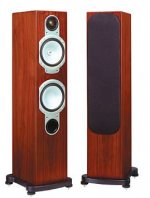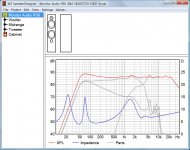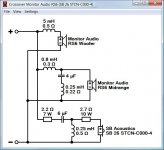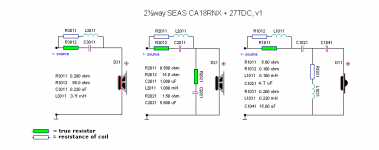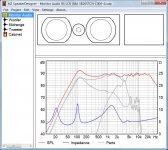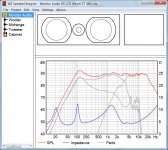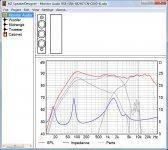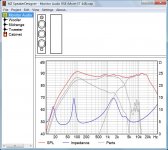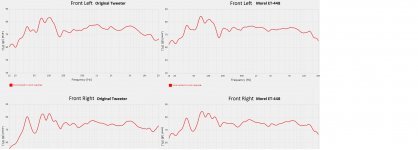Sure, one is free to do just about anything, only in my opinion it doesn't make sense to think about changing drive units before exhausting all XO modification options an then listening. Even then, if one is still not satisfied with results, the next best thing is to get rid of the whole product and sell it in its original condition.
Ah, the frustrations of diyaudio!
Nobody wants to do any diy, when it comes to it.
You guys have this speaker in front of you. Me, I'm guessing. If you can't trace a schematic, or measure a cutout hole on a baffle, how you going to do stuff?
It's actually a good jazz speaker, by all accounts:
But I have seen so many versions of the crossover, which has clearly evolved, that I don't know what is going on. Somebody needs to roll their sleeves up here.
From what I am seeing, the tweeter is crossed quite low, and has reliability issues and a ragged response. I'd be examining whether this 91dB jobbie might fit:
H1212-06 27TBFC/G
Not hard to adjust the resistor at the tweeter filter input. A third order tweeter filter can fill a hole in power response. A zobel (7.5R/0.68) can tame some top end stridency with metal tweeters.
What often happens with commercial designs, is severe compromises are made in crossover just to fit it on the back of a plastic biwired speaker terminal.
IMO, a notch at 5kHz on a 6" metal driver is a good idea. It would be good to actually do some measurement of where the notch should go. The serious diyer has a decent multimeter too. But Dissi's idea of 4uF and 0.25mH shunt can't be wildly off. Really, we are just eating popcorn in the gallery. If you have this speaker, you should try some stuff.
Nobody wants to do any diy, when it comes to it.
You guys have this speaker in front of you. Me, I'm guessing. If you can't trace a schematic, or measure a cutout hole on a baffle, how you going to do stuff?
It's actually a good jazz speaker, by all accounts:
Summing up
When John Atkinson suggested that I review the Monitor Audio Silver RS6, I never expected the level of realism I ended up hearing from this loudspeaker. There's nothing much more I can say—the flawless and exceptional Silver RS6 gave me more listening pleasure than any other loudspeaker I have reviewed for Stereophile. In my more than 20 years of reviewing, I have not reviewed an audio component that produced greater sound quality per dollar than Monitor Audio's Silver RS6.
Read more at Monitor Audio Silver RS6 loudspeaker | Stereophile.com
But I have seen so many versions of the crossover, which has clearly evolved, that I don't know what is going on. Somebody needs to roll their sleeves up here.
From what I am seeing, the tweeter is crossed quite low, and has reliability issues and a ragged response. I'd be examining whether this 91dB jobbie might fit:
H1212-06 27TBFC/G
Not hard to adjust the resistor at the tweeter filter input. A third order tweeter filter can fill a hole in power response. A zobel (7.5R/0.68) can tame some top end stridency with metal tweeters.
What often happens with commercial designs, is severe compromises are made in crossover just to fit it on the back of a plastic biwired speaker terminal.
IMO, a notch at 5kHz on a 6" metal driver is a good idea. It would be good to actually do some measurement of where the notch should go. The serious diyer has a decent multimeter too. But Dissi's idea of 4uF and 0.25mH shunt can't be wildly off. Really, we are just eating popcorn in the gallery. If you have this speaker, you should try some stuff.
Attachments
I tried some replacement tweeters in my simulation and got some interesting results.
The Morel ET 448 has been reported as promising candidate. The simulation shows a very nice result and confirms full compatibility. No crossover modification is required. The same applies to the Morel CAT 408. However, these are rather large domes and they are quite expensive.
A cheaper solution, but not lower in quality, is the SB Acoustics SB26STCN-C000-4. This is a 4 ohm tweeter and it needs an additional resistor between crossover and driver. But the result is amazing (at least in the simulation). Everything falls into place.
The Morel ET 448 has been reported as promising candidate. The simulation shows a very nice result and confirms full compatibility. No crossover modification is required. The same applies to the Morel CAT 408. However, these are rather large domes and they are quite expensive.
A cheaper solution, but not lower in quality, is the SB Acoustics SB26STCN-C000-4. This is a 4 ohm tweeter and it needs an additional resistor between crossover and driver. But the result is amazing (at least in the simulation). Everything falls into place.
Attachments
I bought the cinema package rs6/rs1/rs lcr and subwoofer a great deal at the time used the guy selling built a cinema in his house,only wanted the RS6 but price got the lot for a song, he was running an onkyo amp and it was good.
the guy selling built a cinema in his house,only wanted the RS6 but price got the lot for a song, he was running an onkyo amp and it was good.
They blew me away and my father, who have both messed about with hi-fi for years. The RS6 sat listening to them gave us both an insight into music drifting back n forth left to right holographic unrealism no longer just good sounding music but............binning cds with crap recordings very revealing.
I still have them but after playing around with compression drivers horns and twin 15" drivers they run out of steam but are fantastic for their price point and footprint. Iwould recomend them to anyone to try,
but are fantastic for their price point and footprint. Iwould recomend them to anyone to try,
watching with interest
They blew me away and my father, who have both messed about with hi-fi for years. The RS6 sat listening to them gave us both an insight into music drifting back n forth left to right holographic unrealism no longer just good sounding music but............binning cds with crap recordings very revealing.
I still have them but after playing around with compression drivers horns and twin 15" drivers they run out of steam
watching with interest
Charlie,
Yeah, that's my point too. They sound much better than they measured. Of course, when I had them I didn't have the tools and addiction to modding things I do now.
It's interesting also to look at the response of the latest generation of MA speakers both in the frequency and time domain. Their top speakers measure superbly.
Best,
E
Yeah, that's my point too. They sound much better than they measured. Of course, when I had them I didn't have the tools and addiction to modding things I do now.
It's interesting also to look at the response of the latest generation of MA speakers both in the frequency and time domain. Their top speakers measure superbly.
Best,
E
We do seem to be making progress on this. My theory is that Monitor Audio have evolved this one a bit after a shaky start.
Dissi's image with his 4 ohm tweeter:
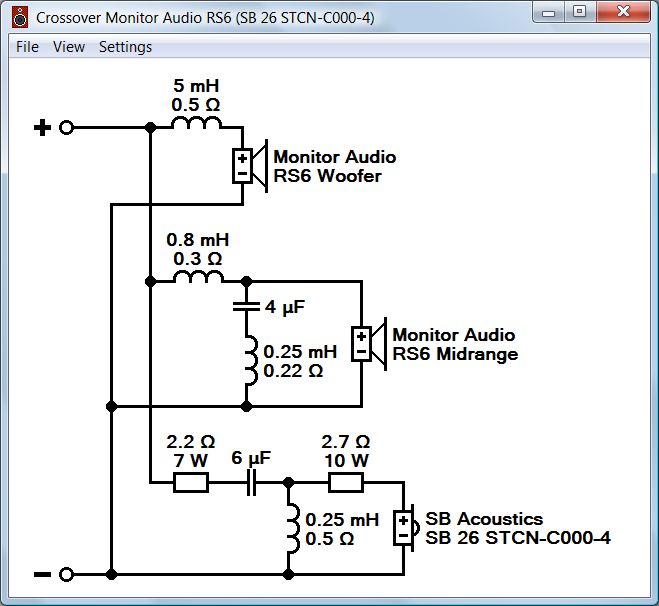
I was hoping Troels Gravesens's 6" metal woofer CNO-25 was going to enlighten us:
CNO-25
But, alas a partially series crossover, which is a bit confusing. It's an interesting fact that series crossovers have an element of notch built into them anyway, and work particularly well with 6" drivers, IMO.
But his 6" paper cone CA18RNX 2.5 way is very interesting:
CA18RNX
Crossover fans will notice the 5kHz tank notches on bass and mid. This could be just what we want. The 1:3 (4.7uF/0.22mH/15uF) capacitor ration 3kHz BW3 tweeter filter is familiar too, here with a bit of RL rolloff. Trust me on this, 1mH and 1uF makes 5kHz, as does 4uF and 0.25mH as a rule of thumb. Or 3.9mH and 0.22uF, roughly...
Where I'm leading, is it wouldn't be hard to notch the bass driver with a tank.
Dissi's image with his 4 ohm tweeter:

I was hoping Troels Gravesens's 6" metal woofer CNO-25 was going to enlighten us:
CNO-25
But, alas a partially series crossover, which is a bit confusing. It's an interesting fact that series crossovers have an element of notch built into them anyway, and work particularly well with 6" drivers, IMO.
But his 6" paper cone CA18RNX 2.5 way is very interesting:
CA18RNX
Crossover fans will notice the 5kHz tank notches on bass and mid. This could be just what we want. The 1:3 (4.7uF/0.22mH/15uF) capacitor ration 3kHz BW3 tweeter filter is familiar too, here with a bit of RL rolloff. Trust me on this, 1mH and 1uF makes 5kHz, as does 4uF and 0.25mH as a rule of thumb. Or 3.9mH and 0.22uF, roughly...
Where I'm leading, is it wouldn't be hard to notch the bass driver with a tank.
Attachments
I tried some replacement tweeters in my simulation and got some interesting results.
The Morel ET 448 has been reported as promising candidate. The simulation shows a very nice result and confirms full compatibility. No crossover modification is required. The same applies to the Morel CAT 408. However, these are rather large domes and they are quite expensive.
A cheaper solution, but not lower in quality, is the SB Acoustics SB26STCN-C000-4. This is a 4 ohm tweeter and it needs an additional resistor between crossover and driver. But the result is amazing (at least in the simulation). Everything falls into place.
Hi Dissi,
I'm looking to upgrae the tweeters in my RS8 and RSLCR speakers. I've destroyed three tweeters already and the TRS-025 is clearly a very cheap tweeter even though MA charge £50 for a replacement. The RS6 probably sound better overall, as the RS8s are quite boomy in addition to having the bright top end.
Would you be able to advise if the ET-448 is compatible with these speakers or whether crossover mods are required? Likewise, could you advise on the additional resistor value for these if I went for the SB Acoustics tweeters instead?
I'd be very grateful for your help as been looking to upgrade these for years but don't quite have the budget for entirely new units.
Attachments
Hi meeko,
I now have verified my simulations and came to the conclusion, that the sensitivity of the RS speakers actually is higher than I assumed. As consequence the Morel CAT 408 drops out of the list because it is too silent. The additional resistor required for the SB26 now is only 1 ohm. The resistor even can be omitted when a hot top end is preferred. Adjust it to your taste.
I have no idea if the replacement tweeters do fit mechanically. But the simulations for the RS8 and the RS LCR look promising IMO. Except for the additional 1 ohm resistor in case of the SB26 there's no crossover modification required.
Good luck, and don't buy the Morels, they are too expensive!
I now have verified my simulations and came to the conclusion, that the sensitivity of the RS speakers actually is higher than I assumed. As consequence the Morel CAT 408 drops out of the list because it is too silent. The additional resistor required for the SB26 now is only 1 ohm. The resistor even can be omitted when a hot top end is preferred. Adjust it to your taste.
I have no idea if the replacement tweeters do fit mechanically. But the simulations for the RS8 and the RS LCR look promising IMO. Except for the additional 1 ohm resistor in case of the SB26 there's no crossover modification required.
Good luck, and don't buy the Morels, they are too expensive!
Attachments
Many thanks for the simulations - good to know they're both compatible. I've just purchased some Clarity Caps, Mundorf Resistors and Vishay MKP1837s, but will return them as having researched more I suspect it's just snake oil. Instead I'll go with the tweeter upgrade. The SB26 are about £25ea and the ET448 are £94 - huge difference!
Looks like mechanically the SB26 will fit almost perfectly, and maybe even fit the original screw holes. The ET448 will also fit, but will need 4 x new holes per speaker and 2 additional screws.
Money no object - are the Morels worth it? Ideally you'd audition both, but I don't have that luxury!
Looks like mechanically the SB26 will fit almost perfectly, and maybe even fit the original screw holes. The ET448 will also fit, but will need 4 x new holes per speaker and 2 additional screws.
Money no object - are the Morels worth it? Ideally you'd audition both, but I don't have that luxury!
Dissi's simulation, and TBH, I don't know how he did it except he designs these things, is extremely useful:
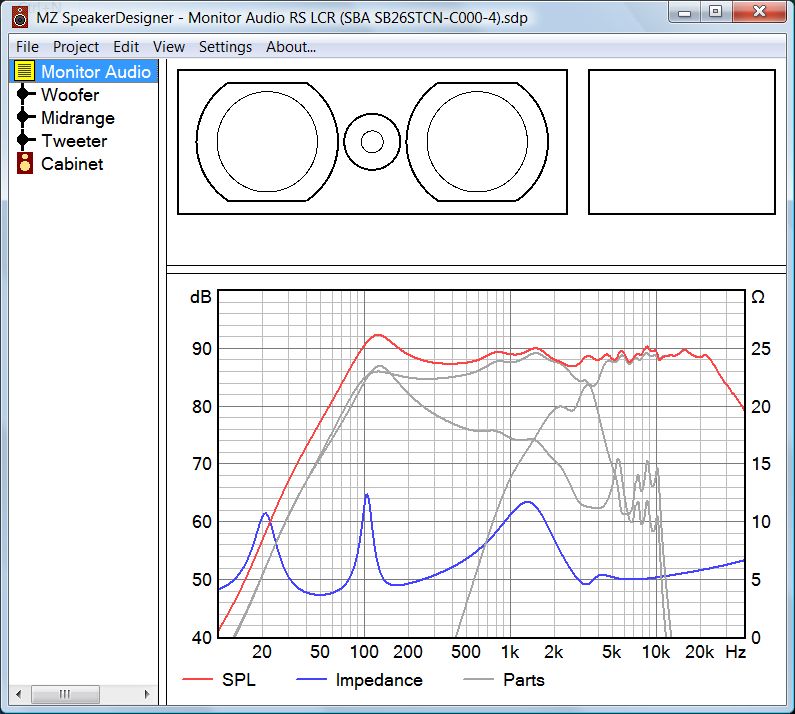

Roughly based on the above crossover and the SB26STCN-C000-4 :: SB Acoustics, though MA seem to be using a 6.5mH bass coil and 0.2mH elsewhere in your (meeko's) latest schematics. And a bit of fiddling with tweeter level.
What I noticed about Dissi's sim, is the bass is actually contributing more breakup hash than the mid.
Which says to me a tank notch on the bass is a very good and cheap idea.
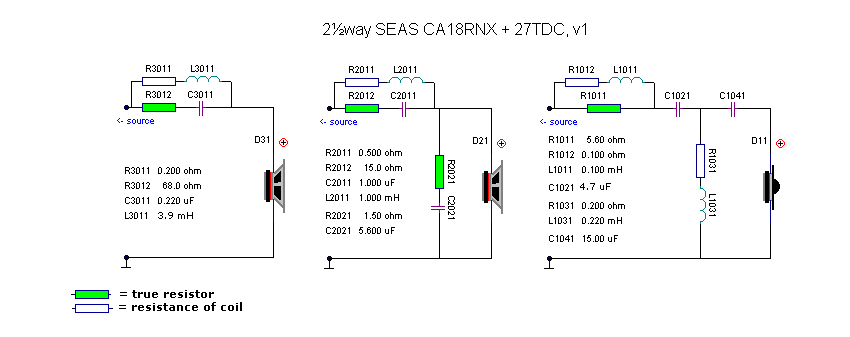
I'd suspect that one soft-dome tweeter is much like another, and SB make particularly good ones at low prices. I was looking at Dissi's sim and thinking the notch was too low at 5kHz. 6kHz would be better. So 4uF and 0.2mH shunt on the mid, it is. The bass tank would be a cheapish CR. On 6.5mH, it must be about 0.12uF and 47R, keeping the LC product constant.
A 5W resistor and a little 0.12uF polypropylene (MKP) or mylar (MKT) is cheap entertainment. I agree with you about snake oil. Only real quality difference in components I can justify on scientific and measurable grounds is better air coils replacing ferrites.


Roughly based on the above crossover and the SB26STCN-C000-4 :: SB Acoustics, though MA seem to be using a 6.5mH bass coil and 0.2mH elsewhere in your (meeko's) latest schematics. And a bit of fiddling with tweeter level.
What I noticed about Dissi's sim, is the bass is actually contributing more breakup hash than the mid.
Which says to me a tank notch on the bass is a very good and cheap idea.

I'd suspect that one soft-dome tweeter is much like another, and SB make particularly good ones at low prices. I was looking at Dissi's sim and thinking the notch was too low at 5kHz. 6kHz would be better. So 4uF and 0.2mH shunt on the mid, it is. The bass tank would be a cheapish CR. On 6.5mH, it must be about 0.12uF and 47R, keeping the LC product constant.
A 5W resistor and a little 0.12uF polypropylene (MKP) or mylar (MKT) is cheap entertainment. I agree with you about snake oil. Only real quality difference in components I can justify on scientific and measurable grounds is better air coils replacing ferrites.
Hi all,
So I opted for the Morels and have been auditioning them all weekend. While I couldn't perform an A/B test, after listening to the RS8s for 10 years, there is a significant difference. With the original C-CAM tweeters the speakers tended towards bright and were tiring during long listening sessions - tending towards being a little harsh. This has completely disappeared. The sound is more airier, with small details easier to distinguish, and even at high listening levels the top end is smooth. Whether or not this is because the SPL will be different, perhaps a little higher than before I can't tell. I'm very happy with the upgrade and can now take comfort that I won't destroy these tweeters as easiliy as the last.
Thanks all for your help!
So I opted for the Morels and have been auditioning them all weekend. While I couldn't perform an A/B test, after listening to the RS8s for 10 years, there is a significant difference. With the original C-CAM tweeters the speakers tended towards bright and were tiring during long listening sessions - tending towards being a little harsh. This has completely disappeared. The sound is more airier, with small details easier to distinguish, and even at high listening levels the top end is smooth. Whether or not this is because the SPL will be different, perhaps a little higher than before I can't tell. I'm very happy with the upgrade and can now take comfort that I won't destroy these tweeters as easiliy as the last.
Thanks all for your help!
Hi all,
I've attached a picture showing in-room measurements using my Anthem MRX720 ARC 1M Calibration software. It uses a calibrated microphone and is useful for seeing the difference in response with the Morel ET-448.
As you can see the peaks at 2k and 5k are smoothed a little and the Morel is definitely louder between around 10k-16k but not so sensitive beyond that.
I've listened to these for many hours now and the difference in clarity and enjoyment especially in acoustic tracks is night and day.
Thanks,
Steve
I've attached a picture showing in-room measurements using my Anthem MRX720 ARC 1M Calibration software. It uses a calibrated microphone and is useful for seeing the difference in response with the Morel ET-448.
As you can see the peaks at 2k and 5k are smoothed a little and the Morel is definitely louder between around 10k-16k but not so sensitive beyond that.
I've listened to these for many hours now and the difference in clarity and enjoyment especially in acoustic tracks is night and day.
Thanks,
Steve
Attachments
Always good to get some feedback, Steve.
I notice the 2dB hole is still there from 2-5kHz.
This is another variant:
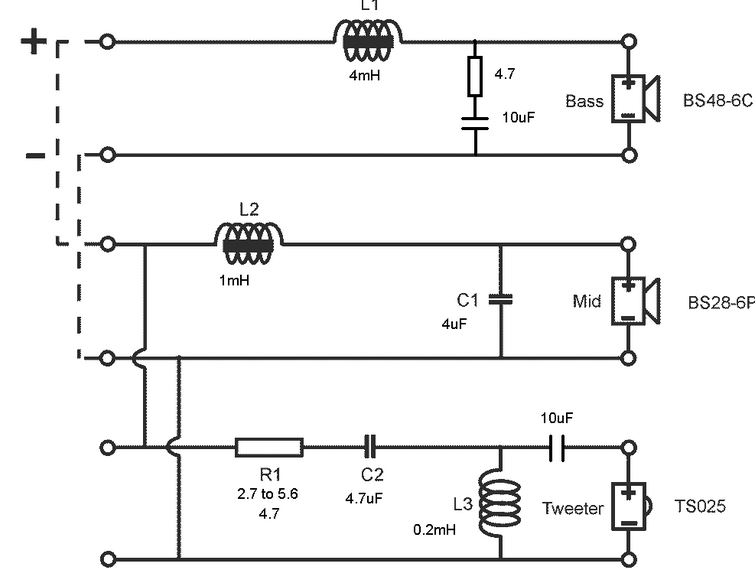
I see no need to change the 6uF if that is what you have, but I found a 10uF after the 0.25mH (or 0.2mH) almost exactly filled the tweeter hole. Worth trying, IMO.
I notice the 2dB hole is still there from 2-5kHz.
This is another variant:

I see no need to change the 6uF if that is what you have, but I found a 10uF after the 0.25mH (or 0.2mH) almost exactly filled the tweeter hole. Worth trying, IMO.
Thanks for the tip - the whole in the RSLCR is even bigger, so I presume 10ufF would be sufficient there too?
Any recommendations on capacitor to use? MLP 5% OK?
Is there an easy place to add it onto the crossover PCB? I wonder if it's acceptable to solder it directly between the PCB and the tweeter +ve wire as space is quite tight.
Any recommendations on capacitor to use? MLP 5% OK?
Is there an easy place to add it onto the crossover PCB? I wonder if it's acceptable to solder it directly between the PCB and the tweeter +ve wire as space is quite tight.
Hi folks! Totally green here. Anybody knows if these could work without any XO mods?: H0831-06 27TFF
Following on from meeko results I also upgrade my RS8's with the Morel Elite ET 448.
They are a significant improvement over Monitor Audio's TRS-025; it has to be said those are pretty poor with their uneven response and horrible 'oil can resonance' spike at 20KHz. No crossover mod's were required.
They're also quite a neat fit in the original baffle and drilling new holes for the mounting screws isn't too scary if you take your time. Ideally they should be recessed further for better driver alignment, but the same can be said for the originals too.
I obtained mine from SoundImports in Europe, very professional service.
A massive thanks to Dissi for his original crossover modelling work and recommendation.
Obviously the cost has to be considered, but I'd highly recommend them to anyone looking to improve their RS series speakers. They offer a great improvement in overall balance, detail and imaging.
This wasn't my first RS8 modification, but it was one I wished I'd done earlier.
From experience, I'd actually recommend improvements in the following sequence:
1. Change the woofer and mid-range driver iron core inductors for high quality air core inductors (bass depth and punch, huge improvement in mid-range clarity!)
2. Resonance damp the cabinets using bitumen pads. Also damp the bass and mid-range magnet shrouds
3. Replace the tweeters
4. Replace the crossover capacitors and resistors (improved clarity, less smearing during complex passages)
5. Rewire the drivers
6. Remove the mix of metals from the crossover connection path
7. Replace the magnetic torx screws used to retain the drivers and crossover with stainless steel equivalents. Check and fix spike mountings.
In combination with the above, correct placement and room treatment have provided a massive improvement in enjoyment. You'll be really surprised what can actually be achieved here.
I'll post more details and images soon.
They are a significant improvement over Monitor Audio's TRS-025; it has to be said those are pretty poor with their uneven response and horrible 'oil can resonance' spike at 20KHz. No crossover mod's were required.
They're also quite a neat fit in the original baffle and drilling new holes for the mounting screws isn't too scary if you take your time. Ideally they should be recessed further for better driver alignment, but the same can be said for the originals too.
I obtained mine from SoundImports in Europe, very professional service.
A massive thanks to Dissi for his original crossover modelling work and recommendation.
Obviously the cost has to be considered, but I'd highly recommend them to anyone looking to improve their RS series speakers. They offer a great improvement in overall balance, detail and imaging.
This wasn't my first RS8 modification, but it was one I wished I'd done earlier.
From experience, I'd actually recommend improvements in the following sequence:
1. Change the woofer and mid-range driver iron core inductors for high quality air core inductors (bass depth and punch, huge improvement in mid-range clarity!)
2. Resonance damp the cabinets using bitumen pads. Also damp the bass and mid-range magnet shrouds
3. Replace the tweeters
4. Replace the crossover capacitors and resistors (improved clarity, less smearing during complex passages)
5. Rewire the drivers
6. Remove the mix of metals from the crossover connection path
7. Replace the magnetic torx screws used to retain the drivers and crossover with stainless steel equivalents. Check and fix spike mountings.
In combination with the above, correct placement and room treatment have provided a massive improvement in enjoyment. You'll be really surprised what can actually be achieved here.
I'll post more details and images soon.
Last edited:
The RS8 woofer low pass filter rear mounted iron core inductor (L1 6.5mH in the XRS8 (v2) crossover):

(note the quality soldering on the original PCB)
and L2 0.8mH iron core inductor for the mid-range band pass filter at the base of the image:

They were replaced with Jantzen Audio air core parts wound from high purity 4N copper wire. Mid-range:


and for the woofer:

the mounting is made from bitumen sheet and due to its size and weight the coil relocated from the rear of the PCB to behind the top bass driver:

As mentioned previously, I'd recommend the inductors are the first item looked at as they are reasonably inexpensive and provided a significant improvement in clarity, taming the edge on the mid-range and providing noticeably more depth and drive in the bass.
(note the quality soldering on the original PCB)
and L2 0.8mH iron core inductor for the mid-range band pass filter at the base of the image:
They were replaced with Jantzen Audio air core parts wound from high purity 4N copper wire. Mid-range:
and for the woofer:
the mounting is made from bitumen sheet and due to its size and weight the coil relocated from the rear of the PCB to behind the top bass driver:
As mentioned previously, I'd recommend the inductors are the first item looked at as they are reasonably inexpensive and provided a significant improvement in clarity, taming the edge on the mid-range and providing noticeably more depth and drive in the bass.
- Home
- Loudspeakers
- Multi-Way
- Monitor RS6 - mods for a beginner
